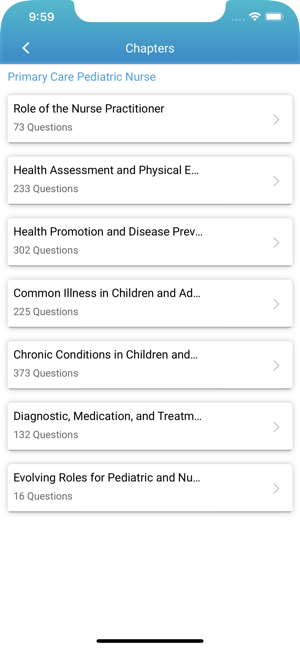價格:免費
更新日期:1970-01-01
檔案大小:74.2 MB
目前版本:1.0.2
版本需求:系統需求:iOS 10.0 或以後版本。相容裝置:iPhone、iPad、iPod touch。
支援語言:英語

This app provides practice questions for recent graduates for both pediatric and family nurse practitioner programs to use in their respective certification exams offered by the PNCB and ANCC. Review questions include the Role of the PNP, Wellness Issues, Growth and Development, Genetics, Chronic Conditions, Pediatric Emergencies, and Pharmacology.
Key Features
UNIQUE! Authored and endorsed by NAPNAP, the only national association of PNPs
UNIQUE! Authored and endorsed by the Association of Faculties of Pediatric Nurse Practitioners (AFPNP)
Multiple-choice practice questions cover all content on both the NCBPNP and ANCC certification exams
Answer key contains rationales for both correct and incorrect responses
Study & Test progress can be tracked and resumed across multiple devices.
Bookmark feature enables you to mark your favorite questions.
Add your own notes to each bookmarked questions for easy understanding.
Access anywhere, no need of internet.
Contents
Section 1: Role of the Pediatric Nurse Practitioner
1. Evolution of the PNP Role
2. Essential Elements of the Advanced Practice Role for PNP
3. Clinical Reasoning and Clinical Decision Making

Section 2: Health Assessment and Physical Examination
4. Measures of Child Growth and Development
5. Assessment of the Head, Eyes, Ears, Nose and Throat
6. Assessment of the Pulmonary System
7. Assessment of the Cardiovascular System
8. Assessment of the Gastrointestinal System
9. Assessment of the Reproductive and Urologic Systems
10. Assessment of the Integumentary System
11. Assessment of the Hematologic and Lymphatic Systems
12. Assessment of the Musculoskeletal System
13. Assessment of the Neurologic System
Section 3: Special Topics in Health Promotion and Disease Prevention
14. Core Concepts in Genetics
15. Immunizations
16. Nutrition

17. Preconceptional and Prenatal Role
18. Care of the Newborn Before Hospital Discharge
19. Newborns and Infants
20. Preterm Infant Follow-up Care
21. Child Abuse and Neglect
22. Toddlers, Preschoolers, and School-agers
23. Mental Health Promotion and Screening for Children and Adolescents
24. Sports Participation: Evaluation and Monitoring
25. Early Adolescents, Late Adolescents, and College-age Young Adults
26. Sexuality and Birth Control
Section 4: Diagnosis and Management of Common Illness in Children and Adolescents
Common Illness of the
27. Head, Eyes, Ears, Nose and Throat
28. Pulmonary System
29. Cardiovascular System

30. Gastrointestinal System
31. Reproductive and Urologic Systems
32. Integumentary System
33. Hematologic and Lymphatic Systems
34. Musculoskeletal System
35. Neurologic System
Section 5: Diagnosis and Management of Chronic Conditions in Children and Adolescents
36. Asthma
37. Cerebral Palsy
38. Childhood Cancer
39. Cleft Lip and Palate
40. Common Genetic Conditions in Children
41. Common Mental Health Disorders in Children and Adolescents
42. Congenital Heart Disease
43. Cystic Fibrosis

44. Diabetes Types 1 and 2
45. Eating Disorders
46. Epilepsy
47. Hemoglobinopathies
48. Juvenile Rheumatoid Arthritis
49. Learning Disorders and Attention Deficit Hyperactivity Disorder
50. Chronic Renal Failure in Children
51. Spina Bifida and Other Myelodysplasias
Section 6: Diagnostic, Medication, and Treatment Guides for Children and Adolescents
52. Readiness for Handling Pediatric Emergencies in the Primary Care Office
53. Diagnostic Tests for Pediatric Clinical Decision Making
54. Pharmacodynamic Considerations Unique to Neonates, Infants, Children, and Adolescents
55. Pain Management for Children
56. Complementary and Alternative Therapy
57. Nonpharmacologic Treatments and Pediatric Procedures

Section 7: Using Evidence-Based Practice to Improve Outcomes in Outpatient Settings
58. Evolving Roles for PNP

支援平台:iPhone, iPad
